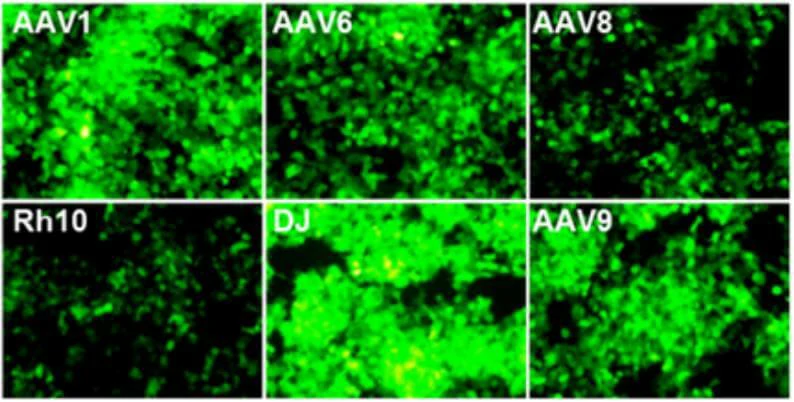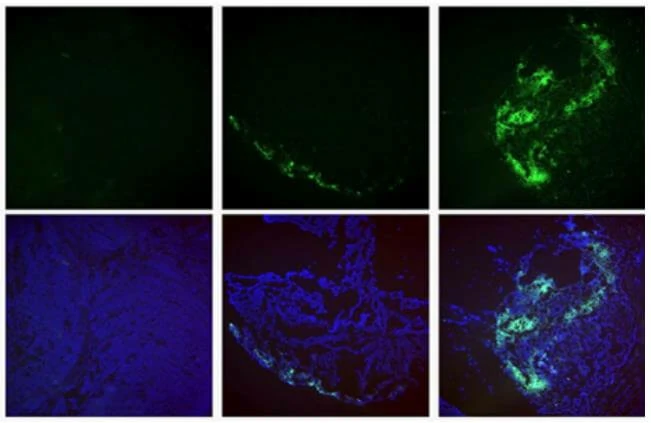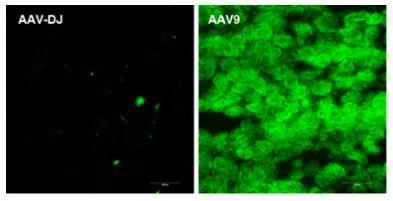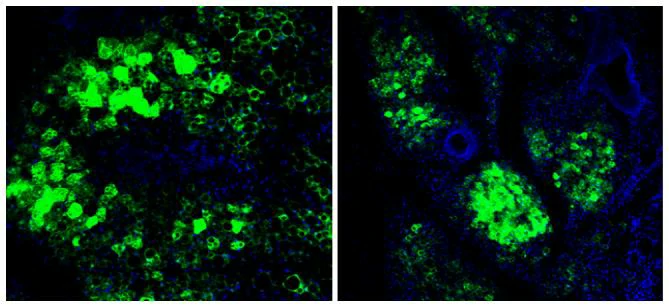AAV9 Rep-Cap plasmid (serotype 9-specific AAV RC9 plasmids) (Amp and Kanamycin) (GeneMedi Owned)
GeneMedi's AAV9 Rep-Cap plasmid supplies the AAV2 Rep (replication) proteins and the AAV9 capsid protein.
You can produce AAV9 particle in 293T cell line in high titer using GeneMedi's AAV9 Rep-Cap plasmid with GM's AAV expression vector (overexpression or shRNA) and AAV helper plasmid.
The tissue tropism of AAV9 vector has been validated in neuron (CNS), lung, liver, heart and muscle, with potential applications in tissue-specific gene therapy.
GeneMedi offers both Ampicillin (Amp) resistance and Kanamycin (Kan) resistance for the AAV Rep-Cap Plasmids.
Product Description
| Cat.NO | Product Name | Organization Type | Price(In USD) | First Order Discount | First Order Discount Price |
|---|---|---|---|---|---|
| P-RC13 | AAV9 Rep-Cap Plasmid (Amp resistance) Size:5ug | Academic | 935 | 50% | 467.5 |
| P-RC13 | AAV9 Rep-Cap Plasmid (Amp resistance) Size:5ug | Biotech & Pharma & Medical Device & Diagnostics | 50% | ||
| P-RC13 | AAV9 Rep-Cap Plasmid (Amp resistance) Size:5ug | CRO&CDMO& CXO&CMC& Manufacturing company |
50% | ||
| P-RC13 | AAV9 Rep-Cap Plasmid (Amp resistance) Size:≥10mg |
All | |||
| P-RC13-Kan | AAV9 Rep-Cap Plasmid (Kan resistance) Size:≥10mg |
All | |||
| P-PK13 | AAV9 Vector
System (Amp resistance)
1. AAV9 Rep-Cap Plasmid, 5ug 2. AAV Helper Plasmid, 5ug 3. pGMAAV-CMV-MCS-T2A-ZsGreen (P-AAVV-B01), 5ug |
Academic | 2028 | 50% | 1014 |
| P-PK13 | AAV9 Vector
System (Amp resistance)
1. AAV9 Rep-Cap Plasmid, 5ug 2. AAV Helper Plasmid, 5ug 3. pGMAAV-CMV-MCS-T2A-ZsGreen (P-AAVV-B01), 5ug | Biotech & Pharma & Medical Device & Diagnostics | 50% | ||
| P-PK13 | AAV9 Vector
System (Amp resistance)
1. AAV9 Rep-Cap Plasmid, 5ug 2. AAV Helper Plasmid, 5ug 3. pGMAAV-CMV-MCS-T2A-ZsGreen (P-AAVV-B01), 5ug | CRO&CDMO& CXO&CMC& Manufacturing company |
50% | ||
| P-PK13 | AAV9 Vector
System (Amp resistance)
1. AAV9 Rep-Cap Plasmid, ≥10mg 2. AAV Helper Plasmid, ≥10mg 3. pGMAAV-CMV-MCS-T2A-ZsGreen (P-AAVV-B01-Kan), ≥10mg |
All | |||
| P-PK13-Kan | AAV9 Vector
System(Kan resistance)
1. AAV9 Rep-Cap Plasmid(Kan resistance), ≥10mg 2. AAV Helper Plasmid(Kan resistance), ≥10mg 3. pGMAAV-CMV-MCS-T2A-ZsGreen (Kan resistance) (P-AAVV-B01-Kan), ≥10mg |
All | |||
|
GeneMedi offers both seed and amplification services for the Amp-resistant AAV Rep-Cap Plasmid. GeneMedi only offers amplification services and do not provide seed for the Kan-resistant AAV Rep-Cap Plasmid currently. |
|||||
| If you want to obtain higher quantities of plasmids (mg), please visit GM TransExcellent Plasmid DNA Rapid Preparation Service. | |||||
|
Terms of sale: For Seed (5ug): The purchaser may not reverse engineer this product to extract the sequence for independent use. The purchaser may not transfer this product to others for manufacturing purposes. The purchaser may not use this material to manufacture this product for any other party. For plasmid production& amplification (≥10mg): The purchaser may not reverse engineer this product to extract the sequence for independent use. The purchaser may not transfer this product to others for manufacturing purposes. The purchaser may not use this material to manufacture this product for themselves or any other party. |
|||||
Citation
| Title | Publication | Date |
|---|---|---|
| LINE-1 promotes tumorigenicity and exacerbates tumor progression via stimulating metabolism reprogramming in non-small cell lung cancer | Molecular Cancer | 2022/7/16 |
| N6-methyladenosine-modified TRAF1 promotes sunitinib resistance by regulating apoptosis and angiogenesis in a METTL14-dependent manner in renal cell carcinoma | Molecular Cancer | 2022/5/10 |
| Mitochondrial fission drives neuronal metabolic burden to promote stress susceptibility in male mice | Nature Metabolism | 2023/11/20 |
| Reduced hepatic bradykinin degradation accounts for cold-induced BAT thermogenesis and WAT browning in male mice | Nature Communications | 2023/5/2 |
| Ferritinophagy Mediated by Oxidative Stress-Driven Mitochondrial Damage Is Involved in the Polystyrene Nanoparticles-Induced Ferroptosis of Lung Injury | ACS nano | 2023/12/12 |
| Endothelial response to type I interferon contributes to vasculopathy and fibrosis and predicts disease progression of systemic sclerosis. | Arthritis & Rheumatology | 2023/7/24 |
| HuR regulates telomerase activity through TERC methylation | NATURE COMMUNICATIONS | 2018/6/7 |
| Splicing factor YBX1 regulates bone marrow stromal cell fate during aging | The EMBO Journal | 2023/3/21 |
| Hexavalent chromium induces γH2AX and RAD51 involved in DNA damage repair in BEAS-2B cells by modulating LNC-DHFR-4: 1 | Environment International | 2023/3/21 |
| Nanoprodrug ratiometrically integrating autophagy inhibitor and genotoxic agent for treatment of triple-negative breast cancer | Biomaterials | 2022/3/10 |
Validation data
.webp)
Virus and titer: AAV9-GFP, AAV9-pTBG-Luciferase (AAV-Luc), 1.4×1012 vg/ml
Animal: mouse, C57, 2 months
Gene delivery method: tail vein, 100μl
Determine assay: 3 weeks post infection, frozen section, immunofluorescence microscopy, in vivo imaging
Conclusion: intravenous injection of AAV9-pTBG-Luciferase (AAV-Luc) only infects liver cells and no non-specific infection

Virus and titer: AAV9-GFP, 1×1012 vg/ml
Animal: Rat, SD, 2 months (Figure 8A, B, C); mouse, C57, 8 months (Figure 8D)
Infection site: heart
Gene delivery method: myocardial in situ injection, 10μl/site, 5 sites in total (Figure 8A, B, C);intraorbital intravenous injection (Figure 8D)
Determine assay: 3 weeks post infection, frozen section, immunofluorescence microscopy

Virus and titer: AAV9-GFP, 1×1012 vg/ml
Animal: Mouse, C57, 2 months
Infection site: Brain
Gene delivery method: Brain localization injection, 1μl
Determine assay: 3 weeks post infection, frozen section, immunofluorescence microscopy

Virus and titer: AAV1/AAV6/AAV8/AAV-Rh10/AAV-DJ/AAV9-GFP, 1×1012 vg/ml
Cells: HEK-293T
MOI: MOI=1×104
Determine assay: 36 hours post infection, immunofluorescence microscopy

Virus and titer: AAV2 (left) /AAV-DJ (middle) / AAV9 (right), 1×1012 vg/ml
Animal: Nude mouse, 2 months
Infection site: Subcutaneous transplant of bowel cancer cells
Gene delivery method: Tumor injection, 10μl/site, 4 sites in total
Determine assay: 3 weeks post infection, frozen section, immunofluorescence microscopy

Virus and titer: AAV9-GFAP-GFP, 1×1012 vg/ml
Animal: mouse, C57, 2 months
Infection site: Hippocampus
Gene delivery method: Brain localization injection, 1μl
Determine assay: 3 weeks post infection, wholemount, immunofluorescence microscopy
-and-AAV9-GFP.webp)
Virus and titer: AAV9-Luciferase (AAV-Luc), AAV9-GFP, 1×1012 vg/ml
Animal: Mouse, C57, 2 months
Infection site: Skeletal muscles
Gene delivery method: Muscle in situ injection, 10μl/site, 4 sites in total
Determine assay: 4 weeks post infection, in vivo imaging, frozen section, immunofluorescence microscopy

Virus and titer: AAV-DJ-GFP, AAV9-GFP, 1×1012 vg/ml
Animal: mouse, C57, 2 months
Infection site: Kidney
Gene delivery method: Multiple sites injection in kidney 10μl/site, 6 sites in total
Determine assay: 3 weeks post infection, frozen section, immunofluorescence microscopy

Virus and titer: AAV9-GFP, 1×1012 vg/ml
Animal: mouse, C57, 2 months
Infection site: Mammary fat pad
Gene delivery method: Breast injection, 10μl/site, 4 sites in total
Determine assay: 3 weeks post infection, frozen section, immunofluorescence microscopy
Associated products and services
| Products & Service | Products & Service Information |
|---|---|
| AAV Packaging service | Detail |
| Promise-ORF™ viral CDNA library | Detail |
| Plasmid DNA Rapid Preparation Service | Detail |






 Go to AAV
vector system
>>
Go to AAV
vector system
>>